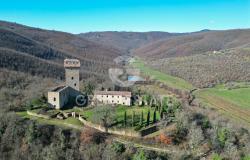Mother Nature, can be the best gardener, as Paul Harcourt Davies discovers in two parts of the peninsula.
Perish the thought that it might be my ‘Italophilia’ creeping in but, in nearly three decades as a professional plant photographer, utterly determined to seek out the best flower sites throughout Europe, I have seldom seen flower meadows to rival those seen all over Italy from high Alps to far south.
There is something special about being able to walk where there are wild flowers in abundance, something definitely conducive to that ‘good to be alive’ feeling even if you can’t put a name to them. The richest wildflower meadows, in terms of the wealth of species, are often to be found on limestone, where there are poor soils and traditional methods of cultivation are employed. The farming regime involves mowing, often by hand with a scythe and no fertilizer other than that ‘donated’ by grazing animals. Often, no more than a handful of species provide the blaze of colour and the glory is transient; delay and, within a few days, blooms have faded or been mown.
Flower Therapy
As soon as you begin walking in those meadows, cares seem to evaporate and you feel delightfully insignificant in the scheme of things: what nasty bank statement? who were those noxious politicians…? Sardinia, Sicily, the Dolomites, have all provided me with sheer joy, but my favourite with a succession of wonderful flowers is the Piano Grande, in the Sibillini National Park (above).
The vast meadow of the Piano Grande now sits where there was once a glacial lake and it is here, when the snow melts, that the pageant of flowers begins with the appearance of countless thousands of purple crocus. Those same snows irrigate the fields at the side of the plain where Italy’s ‘finest’ lentils grow – and if you visit when the crocus appear after the snows melt (left), then you will be grateful for the warmth of the lentil soup available in Castelluccio.

Piano Grande - Sibillini National Park
Spring Glory
A few weeks later, as you approach the plain in the morning, there is often a drift of white below the road but, depending on the sun’s position, this might be invisible later in the day. At close quarters, the true nature of this low mist is revealed and you can pick out innumerable white narcissus (Narcissus poeticus) punctuated by the nodding heads of wild yellow tulips (Tulipa australis – right). A succession of meadow flowers follows quickly with wild pansies, huge blue spikes of Salvia and everywhere, almost as a celebratory chorus, the song of skylarks accompanies your trail.
In mid-June, as you cast your eye around the edges of the plain, you will spy strips of scarlet, purple or even blue depending on the proportions of poppies to cornflowers in the fields. It is never the same fields each year, for cornfield weeds flourish after the soil has been left fallow and then tilled exposing seeds to the oxygen in the air.
Poppies in the Frame
For any photographer, finding a suitable poppy field is the obvious first step – but to capture the glory with your camera takes some ‘tricks of the trade’ in order to create the same impact on a photo that you felt when you first saw the field.
Choose an early morning or, better still, late afternoon and view the field with the sun low in the sky, positioned behind the flowers (but out of sight in your viewfinder). The light has a ‘warmer’ feel and with back-lighting, the translucent scarlet flower petals seem to glow. Use a wide-angle lens (or the wide end of your zoom) if you have one and then kneel as close to the flowers as you need – this way your poppies and cornflowers fill the foreground and you get a lower angle view. You can even set them against the sky and use a polarizing filter to get a deeper blue with that small hilltop town in the background.

Earlier in the year, the best flower meadow will occur further south and my choice is the Gargano peninsula. The flower displays on this giant natural rockery are breathtaking. There is a considerable difference in altitude between the coast and the high stone-strewn fields of Gargano – some 800 to1000 metres, in fact – and as you travel from the coast to the interior you can travel back a month in flowering time. Here, and in much of the south of Italy, roadsides are filled with a colourful weed – the bright yellow Crown daisy (Chrysanthemum coronarium) that seems to sing out and hide all manner of unsightly rubbish under its luxuriant growth. One variety has a creamy-white centre and these flowers literally glow in the sun.
When the Gargano ‘rockery’ is in flower (images, this page), the vivid blue of dyers alkanet (Alkanna tinctoria) mixes with yellow vetches and pink campion to give a multitude of different displays. Wild irises occur in large numbers and can clothe whole hillsides with their spikes in lemon yellow, in blue or in intermediate tones.
Secrets Revealed
But, for me the best of all is a secret world high above San Giovanni Rotondo where, far below, the pilgrims scurry hither and thither as coaches disgorge the faithful, paying a visit to the shrine of Padre Pio.
Nature, the designer, creates combinations from colours that no television garden ‘guru’ would dream of mixing – countless white daisies and yellow buttercups peppered with tiny pansies in blue, yellow, cream and then, with a flourish, there is the ‘vulgarity’ of magenta anemones. It looks wonderful and keen gardeners on our walks have often been inspired by seeing what nature does with a rockery – throw away the pebbles, start with five-ton blocks of limestone and a JCB.
Gargano offers a different kind of ‘meadow’ too, a woodland display under trees in the Foresta Umbra where, in spring, the ground is covered with blue anemones (Anemone appenina), narcissus and the occasional peony (Peonia mascula) and in autumn the high woods are a carpet of pink cyclamen. They are grazed by cows that crop sufficiently high to let so many plants survive and keep down competing grasses.

The Price of Progress
Flower displays are transient and can disappear all too easily with a change in cultivation or management attitude. Years ago, I stopped visiting Greek ruins in spring when spraying with Paraquat began: fortunately, I discovered richer displays in Italy and in Turkey to feed a long-held passion for all things classical. One of the finest floral sights I had ever seen was the temples of Magna Graeca, at Paestum south of Naples (then scaffolding-free), emerging from a sea of poppies and crown daisies. I shiver as I remember, for that was the year of a disaster when a failure at a processing laboratory ruined those films on return to the UK.
Never mind, there would be another time, I thought… but there was not. Just two seasons ago we visited in spring – there was only a laundered, featureless green of the sort beloved of tidy minds and bowling green managers. One man’s glory is another man’s nasty weed but, ever the optimist, I keep hoping that someone might realise that the vibrancy of wild flowers brings breathes life into desiccated ruins













